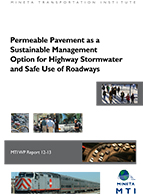- 408-924-7560
- mineta-institute@sjsu.edu
- Donate
Permeable Pavement as a Sustainable Management Option for Highway Stormwater and Safe Use of Roadways
Urbanization has resulted in the replacement of pervious vegetative lands with impervious surfaces such as pavement, which reduces the area where infiltration to groundwater can occur, thus increasing surface runoff into streams or accumulation of stormwater that can lead to flooding. To protect road pavement and travelers from water-related damage, stormwater must be drained from the roadway. Stormwater runoff from roads is known to contain contaminants. Transportation agencies in the country are required by the Environmental Protection Agency (U.S. EPA) to comply with the National Pollution Discharge Elimination Standard (NPDES). These include planning and design permit requirements for the treatment of stormwater runoff to ensure that rainwater runoff from roads (including local, state, and federal roads) do not carry pollutants into receiving water bodies such as rivers, creeks, lakes, and streams. To comply with the U.S. EPA requirements, transportation agencies must implement Stormwater Best Management Practices (BMPs) to capture and treat stormwater runoff from road surfaces.
One of the BMPs is the use of permeable pavement that allows stormwater to move through the pavement layers (away from the road surface) where it can either infiltrate into the soil and groundwater or drain to the road shoulder where it is collected for treatment as needed. There is limited evidence, however, regarding any traffic safety issues associated with highway stormwater and the type of permeable pavement suitable for various traffic requirements.
The primary objective of this project is to conduct a comprehensive literature review on (1) the effect of stormwater on defects of road surfaces (pavement), (2) traffic safety issues associated with highway stormwater, (3) the use of permeable pavement to manage highway stormwater, and (4) the identification of gaps in the existing literature for further research. .
UDEME J. NDON, PhD
Udeme J. Ndon, PhD, is a professor in the Department of Civil and Environmental Engineering at San José State University. Dr. Ndon received his bachelor’s, master’s and doctoral degrees in Civil Engineering from Iowa State University. Dr. Ndon’s concentration for the master’s degree in Civil Engineering was in Civil Engineering Materials (Concrete and Asphalt Materials) and Pavement Engineering. Dr. Ndon’s concentration for the PhD degree was in Environmental Engineering with a minor in Chemical Engineering. Dr. Ndon received his bachelor’s and master’s degree in Mathematics from Harding University and Western Illinois University (Applied Mathematics) respectively prior to enrolling for his engineering degrees at Iowa State University. Dr. Ndon joined San José State University in 1996 as assistant professor and was promoted to associate professor and full professor in 2001 and 2007, respectively. He served as the Department chair for two terms (eight years at four years each term) from August 2008 to August 2016.
Dr. Ndon’s research focuses on water and wastewater treatment, stormwater management and treatment, environmental sustainability, and impact of stormwater on waterways and pavement durability.
Dr. Ndon has published several peer-reviewed journal and conference papers over the last twenty years. He has successfully performed several federal- and/or state-, county/district-, city- and industry-funded environmental projects.
AKTHEM AL-MANASEER, PhD
Akthem Al-Manaseer is the Charles W. Davidson Professor and former chair in the Civil and Environmental Engineering Department at San Jose State University. Dr. Al-Manaseer has been an educator for the last 33 years actively teaching classes on engineering materials and structures.
Dr. Al-Manaseer’s research is focused on construction materials and structures. He co-authored a textbook in its sixth edition on Structural Concrete (published by John Wiley and Sons in 2015) utilizing the IBC, ASCE-7, ACI 318 and AASHTO design codes. He has published more than 70 refereed technical papers and reports dealing with concrete and grout technology, computer modeling of concrete structures, and by-products utilization in concretes. He is the editor of two ACI special-publications (SP) and two international conferences on engineering materials. He has received several research awards on concrete bridges from Caltrans.
-
Contact Us
SJSU Research Foundation 210 N. 4th Street, 4th Floor, San Jose, CA 95112 Phone: 408-924-7560 Email: mineta-institute@sjsu.edu






